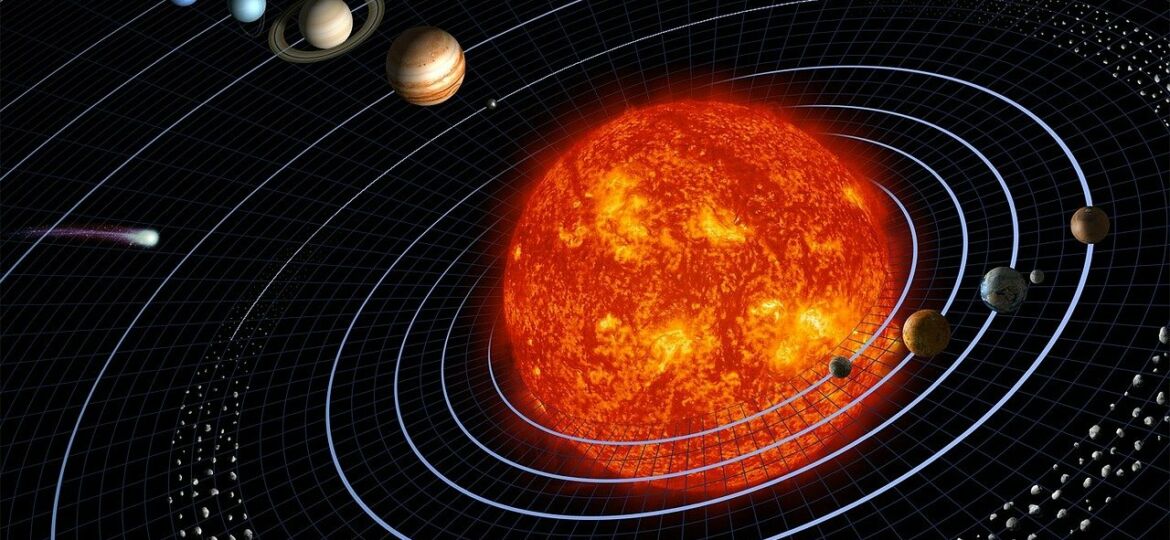
The Earth is supposed to have originated in part from carbonaceous meteorites, which are likely to have come from asteroids in the outer main belt. Telescopic studies of asteroids in the outer main belt imply that they originated with ammonia ice, which is only stable at very low temperatures. According to a recent research, these minerals may have developed extremely far out in the early Solar System and then been brought into the inner Solar System by chaotic mixing processes.
Our Solar System is thought to have evolved from a cloud of gas and dust known as the solar nebula, which started to gravitationally condense on itself 4.6 billion years ago. As the cloud shrank, it started to spin and form itself into a disk rotating around the strongest gravity mass at its center, which would become our Sun. Our solar system received its entire chemical makeup from a previous star or stars that exploded as supernovae. As our Sun developed, it scavenged a broad sample of this material, but the remnant material in the disk started to move depending on its propensity to freeze at a particular temperature.
The Sun scavenged a broad sample of this material as it developed, but the residuals in the disk created solid materials to form planetary bodies depending on their tendency to freeze at a certain temperature. The Sun’s irradiation of the surrounding disk produced a thermal gradient in the early solar system. As a result, the inner planets, Mercury, Venus, Earth, and Mars, are predominantly rock (made up of heavier elements like iron, magnesium, and silicon), while the outer planets are mostly made up of lighter elements like hydrogen, helium, carbon, nitrogen, and oxygen.
The Earth is supposed to have originated in part from carbonaceous meteorites, which are likely to have come from asteroids in the outer main belt. Telescopic studies of outer main-belt asteroids show a consistent 3.1?m reflectance characteristic, indicating that their outer layers contain either water ices or ammoniated clays, or both, which are only stable at very low temperatures. Interestingly, despite the fact that numerous lines of evidence indicate that carbonaceous meteorites are produced from such asteroids, meteorites collected on Earth often lack this trait. As a result, the asteroid belt raises several issues for astronomers and planetary scientists.
According to a recent study headed by experts at Tokyo Institute of Technology’s Earth-Life Science Institute (ELSI), these asteroidal elements may have originated extremely far out in the early Solar System and then been brought into the inner Solar System by chaotic mixing processes. A combination of asteroid observations using the Japanese AKARI space telescope and theoretical modeling of chemical reactions in asteroids suggests that the surface minerals present on outer main-belt asteroids, particularly ammonia (NH3)-bearing clays, form from starting materials containing NH3 and CO2 ice that are stable only at very low temperatures and under water-rich conditions, according to this study. This new research posits that outer main-belt asteroids originated in distant orbits and differentiated to generate various materials in water-rich mantles and rock-dominated cores based on these findings.
The researchers used computer simulations to study the chemical development of numerous possible primordial mixes meant to imitate early asteroidal materials in order to understand the cause of inconsistencies in the recorded spectra of carbonaceous meteorites and asteroids. They then utilized these computer models to generate simulated reflectance spectra to compare to the ones acquired telescopically.
According to their models, in order to match the asteroid spectra, the starting material had to contain a significant amount of water and ammonia, a relatively low abundance of CO2, and react at temperatures below 70?, implying that the asteroids formed much further out than their current locations in the early solar system. The absence of the 3.1 mm characteristic in meteorites, on the other hand, may be ascribed to reactions that occurred deeper within asteroids when temperatures reached greater levels; hence, recovered meteorites may have sampled deeper regions of asteroids.
If this research is correct, it implies that Earth’s creation and unique traits are the outcome of special elements of the Solar System’s development. There will be multiple chances to put this hypothesis to the test; for example, this research predicts what the examination of Hayabusa 2 returning samples will reveal. If this theory is right, it predicts that ammoniated salts and minerals will be found in Hayabusa 2’s returning samples. Analyses of recovered samples from NASA’s OSIRIS-Rex mission will give an additional check on this concept.
This research also looked at whether the physical and chemical circumstances in outer main-belt asteroids may lead to the formation of the discovered minerals. The cold and remote origin of asteroids postulated implies a considerable resemblance between asteroids and comets, raising issues regarding how each of these kinds of bodies evolved.
According to this analysis, the elements that created the Earth may have originated quite far out in the early Solar System and then been brought in during the solar system’s very chaotic early history. Many ringed formations have been discovered in recent investigations of protoplanetary disks by the Atacama Large Millimeter/submillimeter Array (ALMA), which are thought to be direct evidence of planetesimal formation. “Whether our solar system’s birth is a typical conclusion has to be confirmed,” says lead scientist Hiroyuki Kurokawa, “but multiple observations indicate we may be able to set our cosmic history in perspective shortly.”


